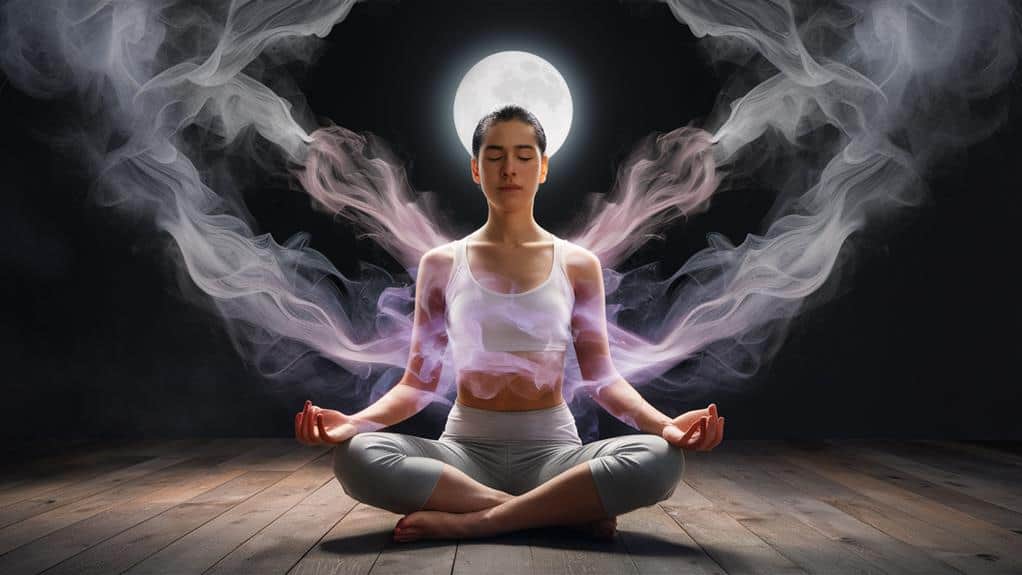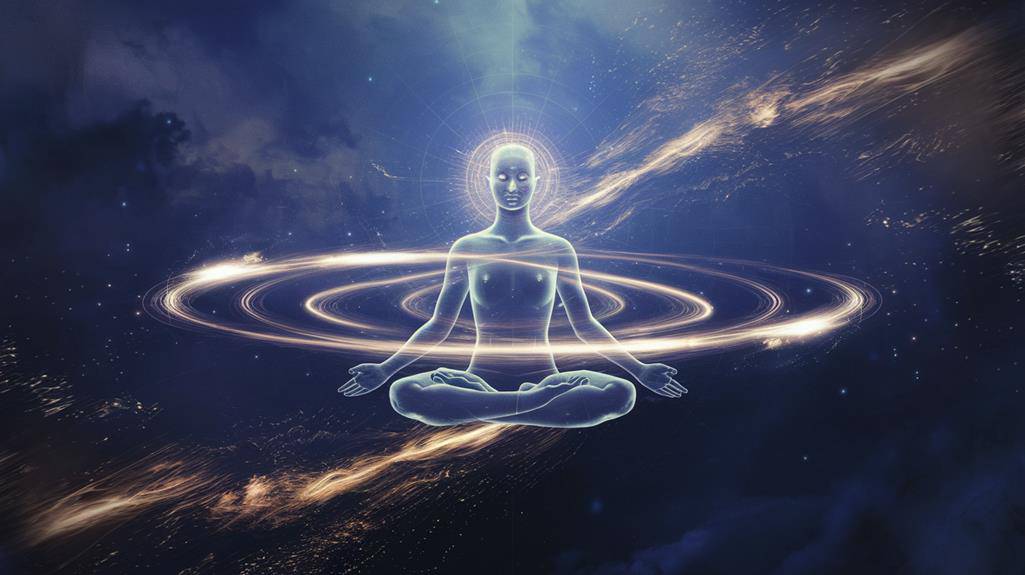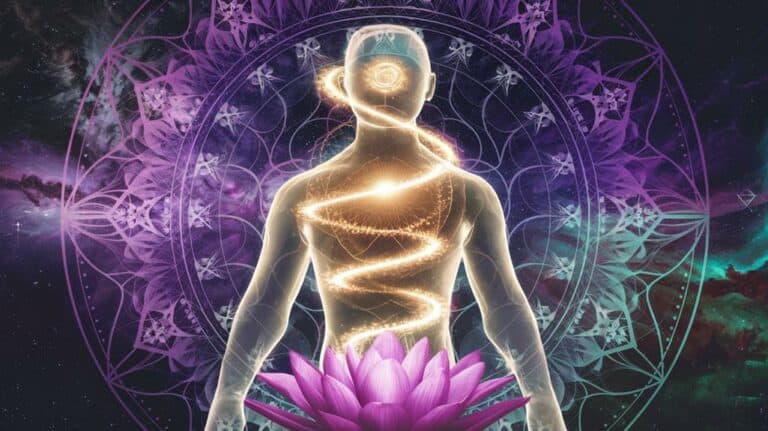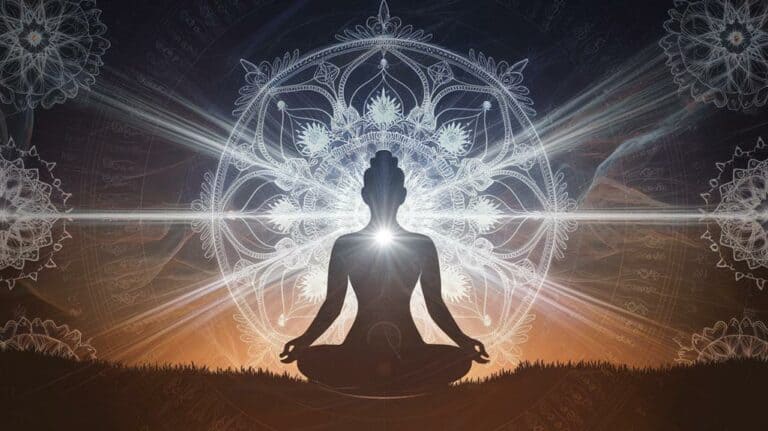The Role of Breath Work in Mystical Practices
You’ve likely noticed that your breath changes with your emotional state – quickening when you’re anxious, deepening when you’re at peace. This fundamental connection between breath and consciousness hasn’t gone unnoticed by mystics and spiritual practitioners throughout history. From the ancient yogis of India to modern-day meditation guides, breathwork has served as a gateway to expanded awareness and profound spiritual experiences. While you might think of breathing as a simple biological function, there’s compelling evidence that specific breathing techniques can activate altered states of consciousness and facilitate direct encounters with what many traditions call the divine.
Ancient Origins of Breath Practices

Throughout ancient civilizations and across the world’s earliest spiritual traditions, breath work has served as a foundational practice for achieving altered states of consciousness.
You’ll find these sacred breathing techniques woven into the spiritual fabric of humanity’s oldest wisdom traditions, from the pranayama practices of ancient India to the measured breathing of Chinese Qi Gong masters.
As you explore these time-honored methods, you’ll discover how your ancestors understood the profound connection between breath and spirit – the very word “spirit” derives from the Latin “spiritus,” meaning breath.
In Egyptian mysticism, you’ll encounter the concept of “sekhem,” the breath of life that animates all beings, while Native American traditions speak of the “Great Breath” that moves through all creation.
These ancient practitioners didn’t just theorize about breath’s transformative power; they developed sophisticated techniques that you can still access today.
Through controlled breathing, they found pathways to transcendent states, healing, and profound spiritual insights.
Their methods weren’t mere respiratory exercises but gateways to expanded consciousness, offering direct experience of what they considered divine reality.
Scientific Basis for Breathwork
Modern scientific research validates what ancient mystics intuitively understood about the power of breath. You’ll find that controlled breathing directly influences your autonomic nervous system, triggering measurable changes in heart rate variability, cortisol levels, and brain wave patterns.
When you engage in specific breath patterns, you’re actually activating your vagus nerve, which serves as a bridge between your conscious mind and your body’s involuntary functions.
Your breath holds the key to accessing altered states of consciousness through its effect on carbon dioxide levels in your bloodstream. When you practice certain breathing techniques, you’re adjusting this delicate balance, which can lead to profound shifts in perception and awareness.
Research has shown that rhythmic breathing practices can increase alpha wave activity in your brain, similar to what’s observed during deep meditation states. Through functional MRI studies, scientists have documented how specific breath patterns can activate regions of your brain associated with emotional regulation and heightened awareness.
You’re not just following ancient wisdom when you control your breath – you’re engaging in a scientifically-proven method of altering your consciousness and accessing deeper states of being.
Pranayama and Yogic Traditions
Ancient yogic traditions elevate pranayama beyond mere breathing exercises, positioning it as a sacred gateway to heightened consciousness and spiritual awakening. When you practice pranayama, you’re not just controlling your breath; you’re tapping into prana, the essential life force that flows through every living being.
This ancient wisdom suggests that through conscious breath control, you’ll access dormant spiritual potential and expand your awareness beyond ordinary reality.
In the yogic understanding, you’ll find eight distinct pranayama techniques, each designed to cultivate specific states of consciousness. Through practices like Nadi Shodhana (alternate nostril breathing), you’re balancing the masculine and feminine energies within your body, while Bhastrika (bellows breath) ignites your inner fire and purifies your entire system.
As you deepen your practice, you’ll discover that pranayama isn’t just about the physical act of breathing – it’s about understanding the subtle relationship between breath, mind, and consciousness. The ancient yogis understood that your breath serves as a bridge between your physical body and spiritual essence, offering you a direct path to transcendent states of being.
Breath in Buddhist Meditation
Buddhist meditation practices place mindful breathing (ānāpānasati) at the core of spiritual development, serving as the foundation for both concentration and insight. As you observe each breath, you’ll discover it’s not just a physiological function but a bridge between your conscious and unconscious mind, between form and emptiness.
Through this practice, you’re cultivating awareness of the present moment, letting go of past regrets and future anxieties.
In Buddhist tradition, you’ll find that breath awareness leads to deeper understanding of impermanence (anicca). Each breath arises and passes away, teaching you the fundamental nature of all phenomena.
When you’re fully present with your breath, you’re participating in what the Buddha called “direct knowing.” You’re not thinking about breathing; you’re experiencing it directly, free from conceptual overlay.
As your practice deepens, you’ll notice how the breath becomes increasingly subtle and refined. This refinement isn’t just about breathing more quietly – it’s about developing a more nuanced awareness of your inner landscape.
The breath becomes your anchor, your refuge, and ultimately, your gateway to liberation.
Sufi Breathing Techniques
Weaving together rhythm and breath, Sufi breathing practices form an integral part of dhikr (remembrance of God) and spiritual transformation. You’ll find these ancient techniques intertwined with movement, chanting, and the heart’s own natural cadence, creating a unified pathway to divine consciousness.
As you engage in these practices, you’re invited to discover how each breath can become a bridge between the mundane and the sacred.
In traditional Sufi circles, you’ll encounter specific breathing patterns that correspond to the divine names of Allah, where each inhale and exhale carries spiritual significance.
There’s a profound emphasis on the breath’s connection to the heart center, where you’ll learn to synchronize your breathing with the remembrance phrases, allowing them to penetrate deeper into your being.
Through sustained practice, you’ll notice how these techniques aren’t merely physical exercises but gateways to expanded awareness and spiritual awakening.
The rhythmic patterns you’ll master serve as vehicles for transcending ordinary consciousness, enabling you to access states of profound unity and divine presence that the Sufis call “fana” – the dissolution of the ego into universal consciousness.
Modern Applications of Mystical Breathing
Contemporary wellness practices have embraced mystical breathing techniques, adapting them to meet modern needs while preserving their transformative essence.
You’ll find these ancient methods woven into mainstream practices like mindfulness meditation, stress reduction programs, and holistic healing modalities, where they’re helping people navigate the complexities of modern life.
In today’s fast-paced world, you can access these powerful practices through digital platforms, wellness centers, and specialized breathing workshops that bridge the gap between ancient wisdom and contemporary understanding.
You’ll discover how traditional Pranayama techniques have evolved into scientifically-supported methods for managing anxiety, enhancing focus, and deepening your spiritual connection.
These adapted practices now incorporate modern research on the nervous system, brain function, and psychological well-being.
You’re part of a growing movement that’s reclaiming these sacred breathing practices while honoring their mystical roots.
Whether you’re practicing box breathing in a corporate setting or exploring transformative breathwork in a retreat space, you’re connecting to a timeless tradition that’s being renewed and reimagined for today’s seekers of truth and transformation.
Altered States Through Breath

Through specific breathing techniques, you can access profound altered states of consciousness that mystics have explored for millennia. As you deepen your breath and slow your rhythms, you’ll find yourself entering domains of awareness that transcend ordinary perception, where the boundaries between self and universe begin to dissolve.
When you engage in circular breathing or holotropic breathwork, you’re tapping into ancient wisdom that recognizes breath as the bridge between material and spiritual domains. You’ll notice that extended periods of controlled breathing can trigger releases of stored emotions, vivid visions, and sensations of floating beyond your physical form.
These aren’t mere physiological responses – they’re gateways to expanded consciousness that yogis and shamans have long understood. The key lies in your willingness to surrender to the process, allowing each breath to guide you deeper into altered domains of mind and spirit.
As your breathing patterns shift, you’ll experience time distortion, enhanced sensory awareness, and profound insights that aren’t accessible in normal waking consciousness. These states aren’t escapes from reality; they’re portals to deeper understanding of your essential nature.
Integrating Breath With Movement
While altered states offer profound insights through breath alone, the sacred union of breath and movement amplifies these mystical experiences.
You’ll discover that when you synchronize your breathing with deliberate physical motion, you’re accessing ancient wisdom that’s been practiced across cultures for millennia. Your body becomes a living temple where breath and movement dance together, creating pathways to heightened awareness and spiritual communion.
As you explore this integration, you’ll find that certain movements naturally align with your breath’s rhythm. When you inhale, you might find yourself reaching skyward or expanding your chest, while exhaling draws you inward or grounds you to the earth.
Through practices like yoga, tai chi, or sacred dance, you’re not just moving through space—you’re weaving together the physical and spiritual dimensions. Each breath-synchronized movement becomes a prayer, a meditation in motion that transcends ordinary consciousness.
You’ll notice how this unified practice dissolves the artificial boundaries between body, breath, and spirit, revealing the profound interconnectedness that’s always existed within you.









